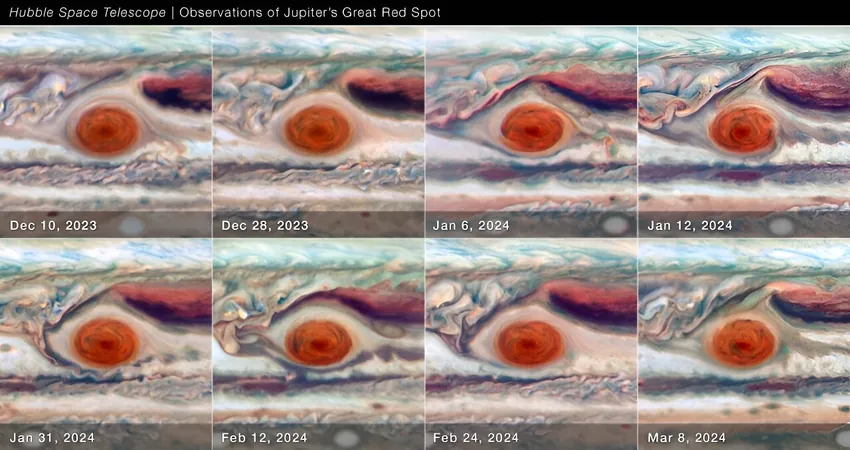
Shocking Changes in Size of Jupiter's Great Red Spot Unraveled by Hubble
2024-10-09
Author: William
Introduction
Astronomers have been captivated by Jupiter's iconic Great Red Spot (GRS), a massive anticyclonic storm that could easily engulf our planet, for over 150 years. Yet, this planetary giant continues to unveil mysteries, particularly with the latest insights from NASA's Hubble Space Telescope.
Recent Observations
Recent observations captured between December 2023 and March 2024 have brought surprising revelations about the behavior of the GRS. Instead of maintaining a consistent form, data suggests that the storm exhibits unexpected fluctuations, "jiggling like a bowl of gelatin," as illustrated in a fascinating time-lapse created from Hubble's images.
Expert Insights
Lead author Amy Simon from NASA’s Goddard Space Flight Center expressed her astonishment: “While we knew its motion varies slightly in longitude, we didn't expect to see the size oscillate. This is unprecedented in our observations.” With Hubble’s exquisite imaging capabilities, Simon and her team have definitively identified that the GRS expands and contracts in rhythm with its speed, a phenomenon that has yet to find an explanation within current hydrodynamic theories.
Broader Implications
Jupiter isn't just an object of curiosity for astronomers; it's also a critical piece in understanding planetary atmospheres beyond our solar system. The GRS and other immense storms offer insights that could translate into understanding weather patterns on exoplanets orbiting distant stars.
The OPAL Program
Through the Outer Planet Atmospheres Legacy (OPAL) program, annually led by Simon, Jupiter and its brethren have been observed systematically for a decade. However, this latest focus on the GRS enabled the researchers to pinpoint critical changes in size and color. Hubble’s ultraviolet observations revealed a core that shines brightest at the GRS's peak size during its oscillation cycle, a sign of reduced haze in the upper atmosphere.
Mechanics of Size Shifts
Co-investigator Mike Wong from the University of California, Berkeley elucidated the mechanics behind these size shifts: “As the GRS accelerates and decelerates, it interacts with the powerful jet streams surrounding it, akin to a sandwich bulging when overstuffed." Unlike Neptune, where dark spots can drift independently without the support of jet streams, Jupiter’s GRS remains anchored at a southern latitude through the influence of these winds.
Future Predictions
Since the inception of the OPAL program, the research team has documented a continued decrease in the GRS's size. They predict that it will continue to shrink but may reach a more stable, less elongated shape within its latitude. "Currently, it is overextending its limits relative to the wind field. Once it contracts within that boundary, the winds will effectively stabilize it," Simon explained.
Conclusion
As scientists hang on to these groundbreaking observations, the quest continues for high-resolution images that could unveil more of Jupiter's enigmatic storms and potentially reveal the underlying causes of such oscillatory behavior. What other secrets does our solar system hold? Stay tuned as astronomers delve deeper into the universe's intriguing mysteries!









 Brasil (PT)
Brasil (PT)
 Canada (EN)
Canada (EN)
 Chile (ES)
Chile (ES)
 España (ES)
España (ES)
 France (FR)
France (FR)
 Hong Kong (EN)
Hong Kong (EN)
 Italia (IT)
Italia (IT)
 日本 (JA)
日本 (JA)
 Magyarország (HU)
Magyarország (HU)
 Norge (NO)
Norge (NO)
 Polska (PL)
Polska (PL)
 Schweiz (DE)
Schweiz (DE)
 Singapore (EN)
Singapore (EN)
 Sverige (SV)
Sverige (SV)
 Suomi (FI)
Suomi (FI)
 Türkiye (TR)
Türkiye (TR)